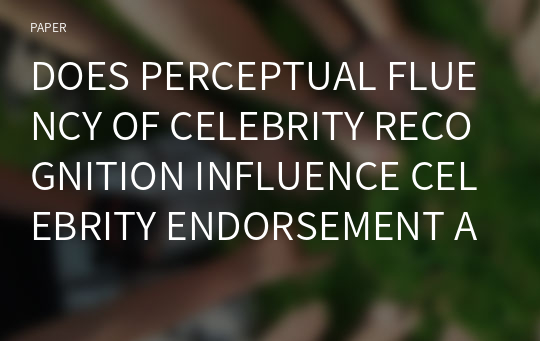DOES PERCEPTUAL FLUENCY OF CELEBRITY RECOGNITION INFLUENCE CELEBRITY ENDORSEMENT ADVERTISING?
* 본 문서는 배포용으로 복사 및 편집이 불가합니다.
서지정보
ㆍ발행기관 : 글로벌지식마케팅경영학회(GFMC)
ㆍ수록지정보 : Global Marketing Conference
ㆍ저자명 : Yongdan Liu, Matthew Tingchi Liu
ㆍ저자명 : Yongdan Liu, Matthew Tingchi Liu
영어 초록
IntroductionShowing friendly, kind, and warm endorsers in advertisement is a common strategy for companies attempting to appeal to their customers on an emotional level. However, these companies may have systematically overlooked one important factor, the perceptual fluency of celebrity recognition. According to the perceptual fluency literature (Lee & Labroo 2004; Winkielman et al. 2012), information that is consistent with one’s existing knowledge is more easily to be processed. Unlike previous endorsement research, this study explored novel pathways of celebrity recognition and examined how the perceptual fluency of the celebrity will impact celebrity endorsement. This study aimed to answer two questions:
⦁ Does perceptual fluency of the celebrity affect how a viewer reacts to an advertisement on the metrics that advertisers care about?
⦁ If perceptual fluency of the celebrity does have an effect, how can advertisers enhance the fluency when creating print advertisements? The current study undertook two studies that provided evidence for the perceptual fluency effect of a celebrity’s physical image on consumers’ recall and attitude towards the endorsement.
Study 1
Study 1 aimed to test the effect of perceptual fluency in the context of banner ads on website. A pre-test is used to examine the perceptual fluency of various outlines from different celebrities under coarse visual condition, and choose the celebrity’s image with the highest deviation regarding perceptual fluency. The pre-test employed 46 grayscale pictures of 18 Chinese celebrities, with two to four images per celebrity. 29 undergraduate students (16 males) took the pre-test. The task was a forced choice two-alternative identification (celebrity: yes or no). Subjects were instructed to identify whether it is a celebrity or not, by pressing the keys “Y” or “N,” respectively. Jet Lee’s (a famous Chinese material artist in Hollywood) images were selected for the main study based on the pre-test results. Evidences (correct rate: 62.1% vs. 20.7%; response time: 0.96 seconds vs. 1.46 seconds) reveal that the respondents experienced higher perceptual fluency in the famous pose condition than in the casual pose condition. The main study used a professionally designed beer advertisement showing Jet Lee as the celebrity endorser. To enhance the external validity of this study, the stimulus advertisement was placed at the lower-left corner, with other advertisements. To ensure the validity of the target group, a representative online sample of male participants was solicited through a professional online panel provider (Erfgen, Zenker & Sattler, 2015). In total, 168 male Chinese participants completed the online survey. Participants were randomly assigned to one of the two experimental conditions (low vs. high perceptual fluency). Erfgen, Zenker and Sattler (2015)’s approach was employed to study advertisement recall. The experimenter informed participants that their mathematical mentality was being tested. They were instructed to read an article about how to teach mathematical mentality to children. However, respondents were not explicitly asked to look at the advertisement. A filtering question was asked about the content of the article, and those who could not answer correctly were excluded from further analyses. Participants then solved four mental math exercises involving basic arithmetic operations, to distract them from the advertisement, before responding to our dependent recall items: unaided recall of the brand, the endorser, and then aided recall of the brand, and endorser (i.e., participants could choose among 10 answer options). Finally, questions about endorser familiarity and some general demographic items were asked. In total, 106 participants answered the filtering question correctly (Mage = 27.9 years, 74.4% with a bachelor’s degree or higher). The endorser familiarity is not significantly different among the two conditions (Mhigh = 5.62 vs. Mlow = 5.78, n.s.). The recall rates confirmed that the use of images with low perceptual fluency impaired endorser recall as compared to the use of images with high perceptual fluency. Unaided endorser name recall was not significantly higher for the high perceptual fluency condition (21.6% correct) as compared to the low perceptual fluency condition (10.9% correct; χ2(1, 106) = 2.23, p = .10, φ = .15). However, for the aided endorser name recall, it was significantly higher in high perceptual fluency condition (29.4% correct) than in low perceptual fluency condition (9.1% correct; χ2(1, 106) = 7.14, p < .01, φ = .26). Brand name recall was not significantly different among the two conditions, both for unaided recall (11.8% vs. 7.3%; n.s.) and aided recall (15.7% vs. 12.7%; n.s.). The results of Study 1 offer evidence for the existence of the perceptual fluency effect by using a realistic advertisement context. Participants exhibited higher recall rates of the endorser’s name for images with high rather than low perceptual fluency, which indicates that even when audiences focus on other tasks, they are more likely to process the advertisement with a high perceptual fluence celebrity image than that with a low perceptual fluence one.
Study 2
Study 2 aimed to test the relationship between perceptual fluency of endorser and consumers’ attitude towards the endorsement. Donnie Yen is considered to be one of Hong Kong’s top action stars. His images were also shown as stimuli in pretest in Study 1. The result revealed that the perceptual fluency of Donnie Yen with a friendly gesture (smiling with an inviting gesture; accurate rate =24%, mean response time = 1.46 seconds) was significantly lower than it was for his image with a provoking gesture (showing a fist with cool expression; accurate rate = 40%, mean response time = 1.03 seconds, p’s < .01). The experiment used a professionally designed advertisement of a virtual “LIMA” brand electric bike showing Donnie Yen as the celebrity endorser. Similar to the method used in study 1, high and low perceptual fluency images of Donnie Yen were used. It is well known that the endorsers’ facial expressions and features have significant impact on advertisement outcomes (e.g. Kulczynski, Ilicic & Baxter 2016; Xiao & Ding 2014). Thus, to rule out the alternative explanation of facial expressions and features, the experiment used a 2 (perceptual fluency: low vs. high) * 2 (celebrity face: face only vs. face and body) between group design. This online study included 108 male Chinese consumers from Sojump (a China-based online panel site). Participants were randomly assigned to one of the four experimental conditions. They were shown a constructed print advertisement pairing Donnie Yen with an electric bike. Participants were instructed to rate the endorser on trustworthiness, likeness, competence, and attractiveness (Tanner & Maeng 2012), following which they were asked to rate their attitude towards the advertisement (Aab), brand (Ab), and purchase intention (PI). Measurement of Aab was based on Mitchell and Olson’s (1981) 5-point semantic differential scale, which includes “this advertisement is: bad/good, dislike/like, and uninteresting/ interesting” (Cronbach’s α = 0.92). Measurement of Ab was based on Carrillat, d’Astous and Christianis’ (2014) model, which includes “For the brand LIMA: I have a negative opinion about/I have a positive opinion about, I do not like/I like, it is untrustworthy/is trustworthy, and it is inferior to other brands/is superior to other brands” (Cronbach’s α = 0.88). Measurement of PI was drawn from Choi and Rifon (2012) by asking “How likely is it that you would consider the advertised brand next time you purchase an electric bike?”. In addition, they were asked to rate the matchiness of the celebrity image shown in the stimuli: “To which degree is the image in the advertisement consistent with the celebrity’s image in your mind?”. Finally, questions about gender, age, and education were asked. Trustworthiness, likeness, competence, and attractiveness were analyzed by using a one-way ANOVA. Results showed no significant differences among the conditions. Attitude towards the advertisement and brand, and purchase intention were analyzed in a 2 * 2 ANOVA with the perceptual fluency and face conditions as independent variables. Results showed main effects of perceptual fluency for attitude towards the advertisement (F(1,107) = 3.47, p = 0.06), attitude towards the brand (F(1,107) = 3.93, p = 0.05), and purchase intention (F(1,107) = 7.35, p < 0.01), but no significant interaction (F’s < 1). A follow-up analysis revealed that, when the celebrity’s face and gesture was presented, high perceptual fluency lead to a higher endorsement effect (MAad = 5.72, MAb = 5.66, MPI = 5.83) than when there was low perceptual fluency (MAad = 5.18, MAb = 5.08, MPI = 5.06; p’s < .05). However, no significant difference was found if only the celebrity’s face was shown (high perceptual fluency: MAad = 5.29, MAb = 5.37, MPI = 5.52; low perceptual fluency face: MAad = 4.94, MAb = 5.18, MPI = 4.96; p’s > 0.05). To investigate whether feelings of image matching mediated the relationship between the perceptual fluency and positive attitude related to the advertisement, the PROCESS macro bootstrapping procedure (n = 10,000, model 4) was performed (Preacher, Rucker & Hayes 2007). Trustworthiness, likeness, familiarity, and attractiveness were included as covariates. The results indicated that the high perceptual fluency produced significant feelings of image matching (β = 0.32, p=0.055), and image matching was a significant predictor of Aad (β = 0.42, p<0.001), Ab (β = 0.27, p<0.001), and PI (β = 0.42, p<0.001). Further, the 95% bootstrapped confidence interval for the indirect effect of perceptual fluency on the dependent variables through the mediator, image matching, did not include zero (Aad: β= 0.13, 95% CI = 0.02–0.30; Ab: β = 0.09, 95% CI = 0.02–0.19; and PI: β = 0.13, 95% CI = 0.02–0.30). These results support the notion that the perceptual fluency of a celebrity stimulus can affect the endorsement positively. Although the traditional influence factors of endorsement (i.e., trustworthiness, likeness, familiarity, and attractiveness) did not differ among the experimental conditions, participants showed significantly different attitudes towards the endorsement. Specifically, when the stimulus contained a celebrity image with high perceptual fluency, participants had significantly positive attitudes towards the advertisement and brand, and a higher purchase intention, as compared to those when a low perceptual fluency image was presented. In addition, the alternative explanation of facial expressions and features was ruled out in this study.
Theoretical contribution
This study contributes to the literature concerning how celebrities on printed advertisements are processed. (1) The current study revealed that the high rather than low perceptual fluency of celebrities’ physical image had higher benefits (e.g., martial art actor showing friendly gesture). The study defined this effect as perceptual fluency of celebrity recognition, which advances the stereotypic filtering mechanism (Sherman et al. 1998) and the fluency-as-good effect (e.g., Reber, Winkielman & Schwarz 1998). (2) This study also contributes to psychology through the assertion that our perception of famous faces can be influenced by the accompanied contextual information. Study 1 demonstrated that, other than the faces, the contextual information (e.g., hairstyle, gesture, and etc.) with high perceptual fluency can facilitate the recognition of celebrities. Study 2 revealed that the effect of perceptual fluency is more salient when the celebrity’s image includes the face and gesture. This result echoes findings from Aviezer et al. (2012), who argued that people tend to combine the face and body together, to create a synergistic effect. (3) Humans have evolved with significant mental capabilities to facilitate the rapid processing of information (Downing et al. 2001). However, the possible influence of such automatic evaluations in marketing contexts has not received sufficient attention. While marketers narrowly focus on manipulating attractiveness, agreeableness, or friendliness of celebrity endorsers, this study suggests that manipulating the perceptual fluency of the endorser may have a higher influence on consumers. These initial findings may help facilitate further marketing research using neuro and visual science methods to examine the perceptual processing of celebrities’ imagery.
Implications for practice
This study highlights the need for marketers to pay more attention to using the perceptual fluency of celebrity endorsers to enhance the endorsement effect. With increasing competition in marketing communications, automatic and holistic processing of the celebrity’s image may influence consumer behaviors in different contexts. Enhancing the perceptual fluency of celebrity images seems to have multiple benefits, including improved recognition, recall, and consumer attitude towards the endorsement. This study also proposes practical methods for the careful selection of celebrity images when constructing print advertisements. Marketers can evaluate the congruence of celebrities’ physical image with coarse visual images of celebrities and conduct pretests to determine the image that suits their printed advertisements.
Limitations and Directions for Future Research
One major limitation of this study is that only action movie stars were studied in the recall (Study 1) and consumer attitude experiments (Study 2). This is because it is a common practice that endorsers are asked to convey friendly signals in the advertisement, such as smiling, friendly body gesture, etc. Such friendly gestures are more likely to lead to low perceptual fluency for action movie stars than for other celebrities. Further evidence may be required for the perceptual fluency of celebrity recognition. Future studies can examine the perceptual fluency effect for other categories of celebrities, such as athletic stars, fashion stars, etc. Second, the current study focused only on male celebrities and male consumers. However, female celebrities are very popular in printed advertisements, especially for cosmetics, personal care, fashion, etc. (Belch & Belch, 2013). Influence of the perceptual fluency of female celebrities and the possible differences in the impact of each gender’s perceptual fluency requires further research. Third, in conducting Study1, the distraction task of mental math exercises only represented a simplification of reality. Future research can use more realistic tasks to enhance the external validity of the findings.
참고 자료
없음"Global Marketing Conference"의 다른 논문
 THE ROLES OF GREEN PACKAGING IN UGLY FOOD PURCHASE INTE..22페이지
THE ROLES OF GREEN PACKAGING IN UGLY FOOD PURCHASE INTE..22페이지 THE IMPACT OF INDUCED AWE ON ETHICAL TOURIST BEHAVIORS5페이지
THE IMPACT OF INDUCED AWE ON ETHICAL TOURIST BEHAVIORS5페이지 A BIBLIOMETRIC ANALYSIS OF SPIRITUAL TOURISM RESEARCH15페이지
A BIBLIOMETRIC ANALYSIS OF SPIRITUAL TOURISM RESEARCH15페이지 SOCIAL NETWORK ANALYSIS AND RESPONSE TIME TESTING: CONS..11페이지
SOCIAL NETWORK ANALYSIS AND RESPONSE TIME TESTING: CONS..11페이지 THE EFFECTS OF PARA-SOCIAL INTERACTION ON ONLINE CELEBR..3페이지
THE EFFECTS OF PARA-SOCIAL INTERACTION ON ONLINE CELEBR..3페이지 THE INFLUENCE OF OPINION LEADERS ON DAILY DEALS USER’S ..3페이지
THE INFLUENCE OF OPINION LEADERS ON DAILY DEALS USER’S ..3페이지 HOW IMMERSIVE RETAILING AFFECTS CONSUMERS’ URGE TO BUY:..6페이지
HOW IMMERSIVE RETAILING AFFECTS CONSUMERS’ URGE TO BUY:..6페이지 KEY TO SUPERSTARDOM IN A GLOBALISED MARKET: THE ROLE OF..6페이지
KEY TO SUPERSTARDOM IN A GLOBALISED MARKET: THE ROLE OF..6페이지 A POST-PANDEMIC LOOK AT TOURISTS’ PERCEIVED COOLNESS OF..4페이지
A POST-PANDEMIC LOOK AT TOURISTS’ PERCEIVED COOLNESS OF..4페이지 EXTRACTING OFFLINE RETAIL SHOPPING PATTERNS: OLLABORATI..5페이지
EXTRACTING OFFLINE RETAIL SHOPPING PATTERNS: OLLABORATI..5페이지




















